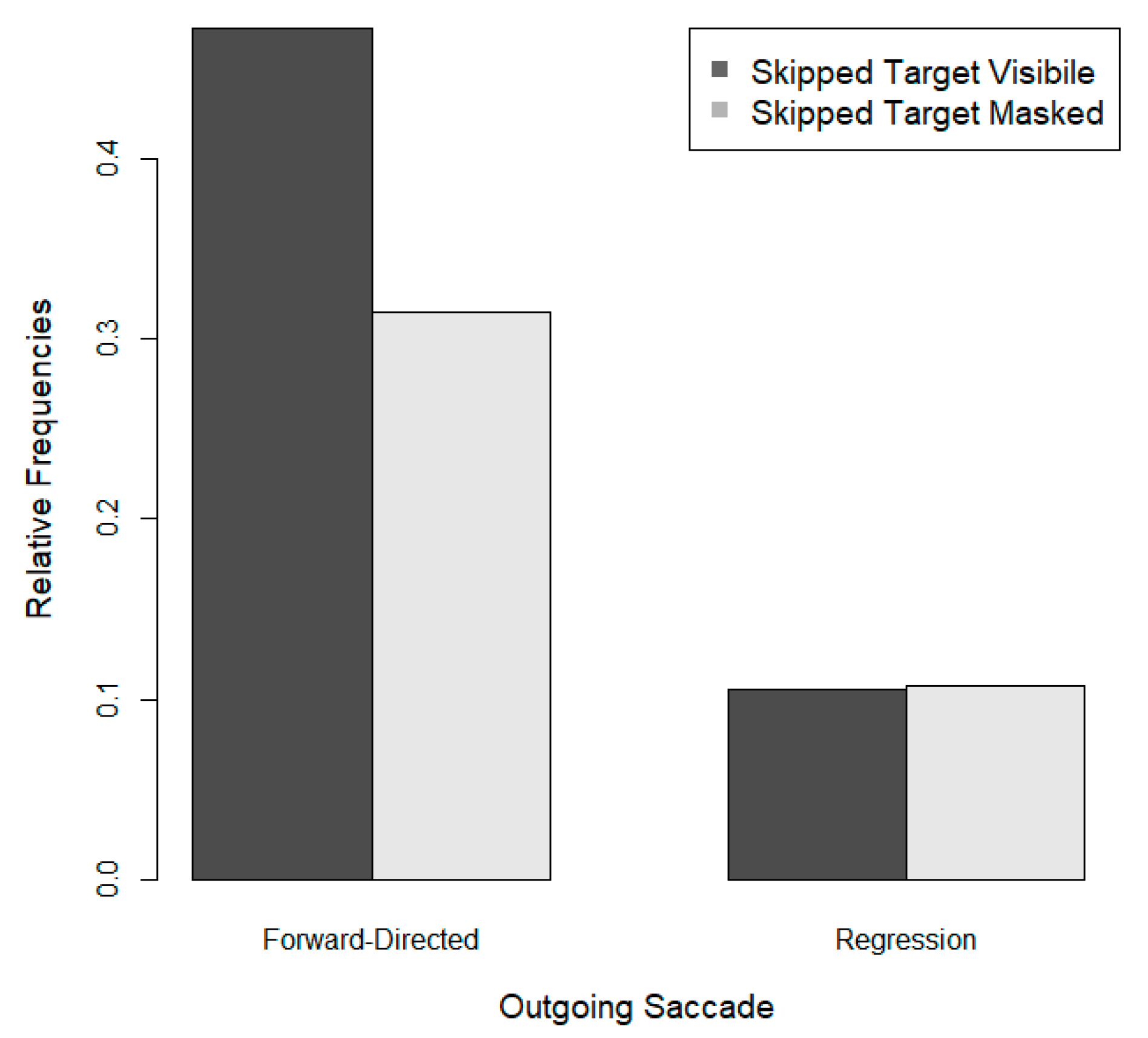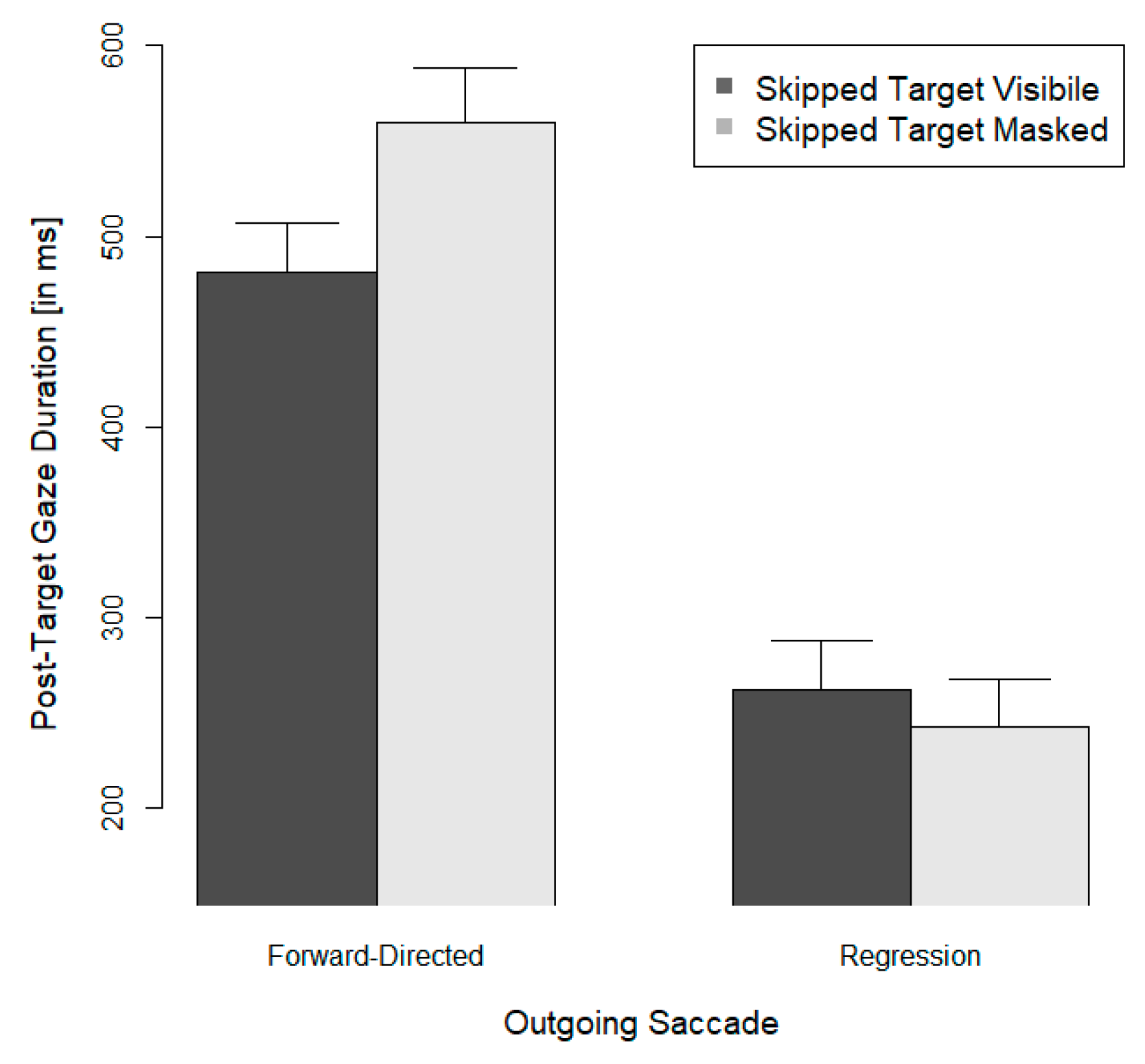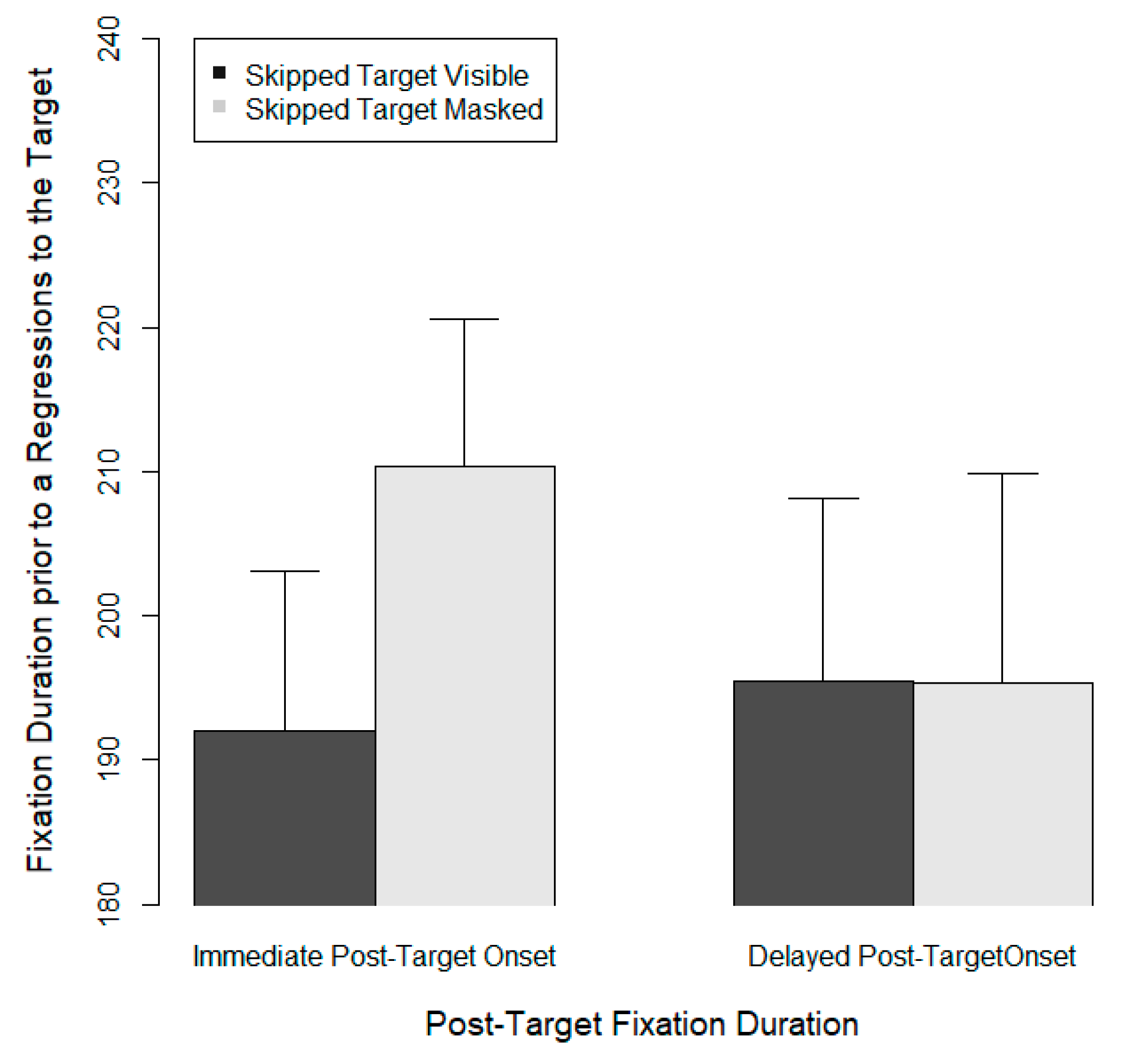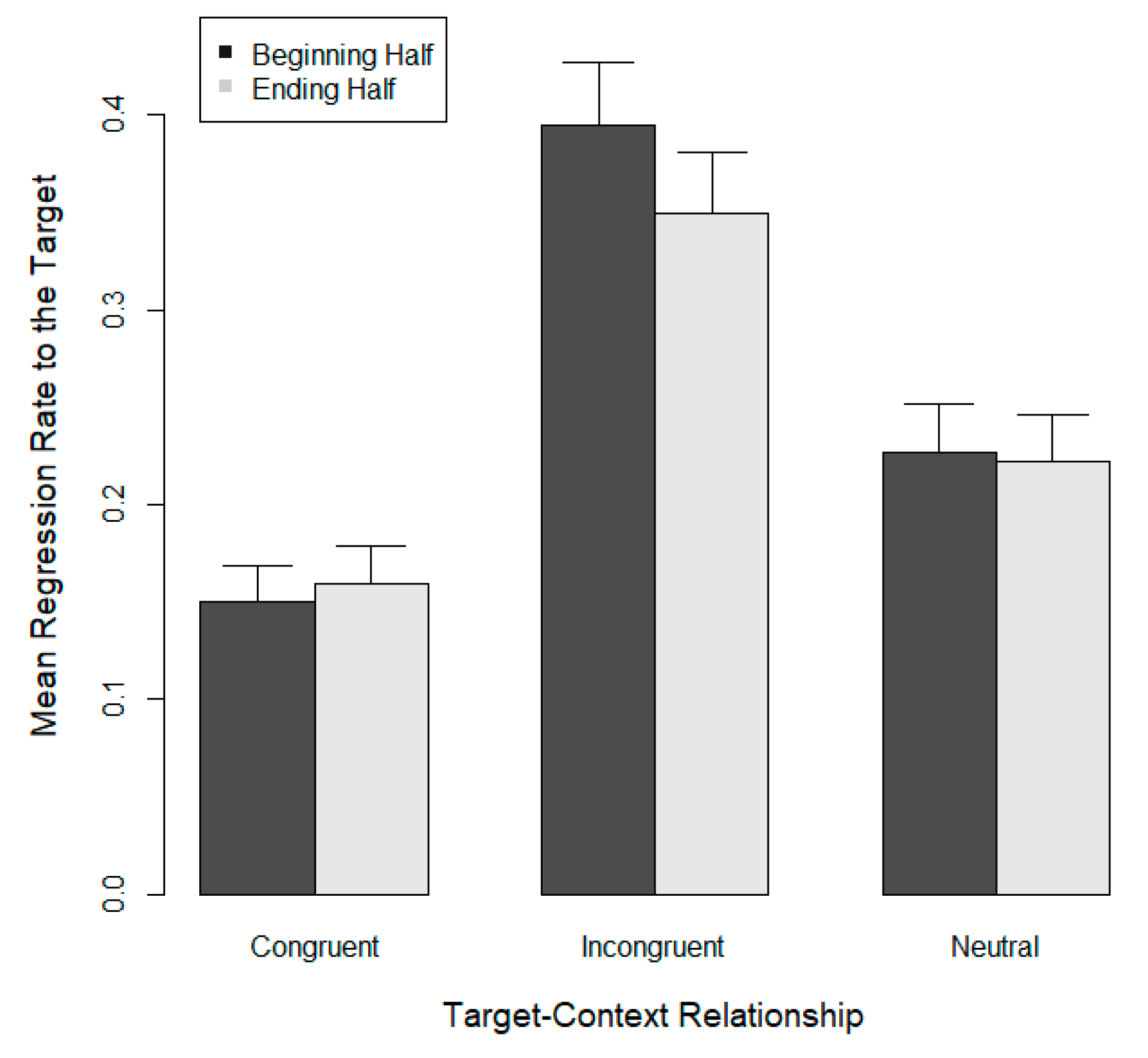Regressions during Reading
Abstract
1. Introduction
2. The Spatial Targeting of Regressions
2.1. Large Regressions
- 1a. The man was looking for a spade in the shed next to the barn. Spade
- 1b. The man was looking for a spade in the shed next to the barn. Shovel
Shortcomings of the Spatial Coding Hypothesis
2.2. Small Regressions
3. The Function of Regressions
3.1. Regressions for Text Comprehension
3.1.1. The Frequency of Regression Usage
3.1.2. The Timeline of Regression Programming
3.2. Small Regressions
3.2.1. Frequency of Small Corrective Regressions
3.2.2. The Time Course for the Programming of Corrective Regressions
4. Individual Differences
5. Regressions and the Teaching of Reading
6. Conclusions
Funding
Conflicts of Interest
References
- Henderson, J.M.; Pollatsek, A.; Rayner, K. Covert visual attention and extrafoveal information use during object identification. Percept. Psychophys. 1989, 45, 196–208. [Google Scholar] [CrossRef] [PubMed]
- Vitu, F.; McConkie, G.W. Reading as a Perceptual Process; Kennedy, A., Radach, R., Heller, D., Pynte, J., Eds.; North-Holland/Elsevier Science Publishers: Amsterdam, The Netherlands, 2000; pp. 301–326. ISBN 978-0-08-043642-5. [Google Scholar]
- Vitu, F. About the global effect and the critical role of retinal eccentricity: Implications for eye movements in reading. J. Eye Mov. Res. 2008, 2, 1–18. [Google Scholar]
- Rayner, K. Eye movements and attention in reading, scene perception, and visual search. Q. J. Exp. Psychol. 2009, 62, 1457–1506. [Google Scholar] [CrossRef] [PubMed]
- Kolers, P.A. Introduction. In The Psychology and Pedagogy of Reading; Huey, E.B., Ed.; MIT Press: Boston, MA, USA, 1968; pp. XIII–XXXIX. ISBN 9780262080293. [Google Scholar]
- Rayner, K.; Kennedy, A. Eye movements and visual cognition: Scene Perception and reading. In Eye Movements and Visual Cognition: Scene Perception and Reading; Springer-Verlag: New York, NY, USA, 1992; pp. 379–396. ISBN 978-1-4612-2852-3. [Google Scholar]
- Kennedy, A.; Baccino, T. The Effects of Screen Refresh Rate on Editing Operations Using a Computer Mouse Pointing Device. Q. J. Exp. Psychol. Sect. A 1995, 48, 55–71. [Google Scholar] [CrossRef]
- Radach, R.; Kennedy, A.; Rayner, K. Eye Movements and Information Processing during Reading: Preface. Eur. J. Cogn. Psychol. 2004, 16, 1–2. [Google Scholar]
- Holmes, V.M.; Kennedy, A.; Murray, W.S. Syntactic Structure and the Garden Path. Q. J. Exp. Psychol. Sect. A 1987, 39, 277–293. [Google Scholar] [CrossRef]
- Fischer, M.H. Memory for Word Locations in Reading. Memory 1999, 7, 79–116. [Google Scholar] [CrossRef] [PubMed]
- Weger, U.W.; Inhoff, A.W.; Weger, U.W. Long-range regressions to previously read words are guided by spatial and verbal memory. Mem. Cogn. 2007, 35, 1293–1306. [Google Scholar] [CrossRef]
- Weger, U.W.; Meier, B.P.; Robinson, M.D.; Inhoff, A.W.; Weger, U.W. Things are sounding up: Affective influences on auditory tone perception. Psychon. Bull. Rev. 2007, 14, 517–521. [Google Scholar] [CrossRef][Green Version]
- Inhoff, A.W.; Greenberg, S.N.; Solomon, M.; Wang, C.-A. Word integration and regression programming during reading: A test of the E-Z reader 10 model. J. Exp. Psychol. Hum. Percept. Perform. 2009, 35, 1571–1584. [Google Scholar] [CrossRef]
- Guérard, K.; Saint-Aubin, J.; Maltais, M. The role of verbal memory in regressions during reading. Mem. Cognit. 2013, 41, 122–136. [Google Scholar] [CrossRef] [PubMed]
- Guérard, K.; Saint-Aubin, J.; Maltais, M.; Lavoie, H. The role of verbal memory in regressions during reading is modulated by the target word’s recency in memory. Mem. Cognit. 2014, 42, 1155–1170. [Google Scholar] [CrossRef] [PubMed]
- Radach, R.; McConkie, G.W. Determinants of Fixation Positions in Words During Reading. Eye Guid. Read. Scene Percept. 1998, 77–100. [Google Scholar] [CrossRef]
- Inhoff, A.W.; Weger, U.W.; Radach, R. Sources of Information for the Programming of Short-and Long-Range Regressions during Reading. In Cognitive Processes in Eye Guidance; Underwood, G., Ed.; Oxford University Press: Oxford, UK, 2005; pp. 33–52. [Google Scholar]
- Friede, A.; Inhoff, A.W.; Vorstius, C.; Radach, R. Visuomotor strategies and the role of spatial memory for regressive saccades in reading. Under reviews.
- Binder, K.S.; Pollatsek, A.; Rayner, K. Extraction of information to the left of the fixated word in reading. J. Exp. Psychol. Hum. Percept. Perform. 1999, 25, 1162–1172. [Google Scholar] [CrossRef] [PubMed]
- Rayner, K. Eye Movements in Reading and Information Processing: 20 Years of Research. Psychol. Bull. 1998, 124, 372–422. [Google Scholar] [CrossRef] [PubMed]
- Carpenter, P.A.; Daneman, M. Lexical retrieval and error recovery in reading: A model based on eye fixations. J. Verbal Learn. Verbal Behav. 1981, 20, 137–160. [Google Scholar] [CrossRef]
- Mitchell, D.C.; Shen, X.; Green, M.J.; Hodgson, T.L. Accounting for regressive eye-movements in models of sentence processing: A reappraisal of the Selective Reanalysis hypothesis. J. Mem. Lang. 2008, 59, 266–293. [Google Scholar] [CrossRef]
- Inhoff, A.W.; Weger, U.W. Memory for word location during reading: Eye movements to previously read words are spatially selective but not precise. Mem. Cognit. 2005, 33, 447–461. [Google Scholar] [CrossRef] [PubMed]
- Laeng, B.; Teodorescu, D.S. Eye scanpaths during visual imagery reenact those of perception of the same visual scene. Cogn. Sci. 2002, 26, 207–231. [Google Scholar] [CrossRef]
- Booth, R.W.; Weger, U.W. The function of regressions in reading: Backward eye movements allow rereading. Mem. Cogn. 2013, 41, 82–97. [Google Scholar] [CrossRef] [PubMed]
- Sturt, P.; Kwon, N. Processing Information during Regressions: An Application of the Reverse Boundary-Change Paradigm. Front. Psychol. 2018, 9, 1630. [Google Scholar] [CrossRef] [PubMed]
- Schotter, E.R.; Tran, R.; Rayner, K. Don’t believe what you read (Only Once): Comprehension is supported by regressions during reading. Psychol. Sci. 2014, 25, 1218–1226. [Google Scholar] [CrossRef] [PubMed]
- Gregg, J.; Inhoff, A.W. Misperception of Orthographic Neighbors during Silent and Oral Reading. J. Exp. Psychol. Hum. Percept. Perform. 2016, 42, 799–820. [Google Scholar] [CrossRef] [PubMed]
- Reichle, E.D.; Reineberg, A.E.; Schooler, J.W. Eye movements during mindless reading. Psychol. Sci. 2010, 21, 1300–1310. [Google Scholar] [CrossRef] [PubMed]
- Apel, J.K.; Henderson, J.M.; Ferreira, F. Targeting regressions: Do readers pay attention to the left? Psychon. Bull. Rev. 2012, 19, 1108–1113. [Google Scholar] [CrossRef] [PubMed][Green Version]
- Folk, J. Multiple Lexical Codes in Reading: Evidence from Eye Movements, Naming Time, and Oral Reading The operation of the lexical and sublexical systems during spelling View project. J. Exp. Psychol. Learn. Mem. Cogn. 1995, 21, 1412–1429. [Google Scholar] [CrossRef]
- Folk, J. Phonological Codes Are Used to Access the Lexicon during Silent Reading The operation of the lexical and sublexical systems during spelling View project. Artic. J. Exp. Psychol. Learn. Mem. Cogn. 1999, 25, 892–906. [Google Scholar] [CrossRef]
- Vitu, F.; McConkie, G.W.; Zola, D. About Regressive Saccades in Reading and Their Relation to Word Identification. Eye Guid. Read. Scene Percept. 1998, 101–124. [Google Scholar] [CrossRef]
- Vitu, F.; McConkie, G.W.; Kerr, P.; O’Regan, J.K. Fixation location effects on fixation durations during reading: An inverted optimal viewing position effect. Vis. Res. 2001, 41, 3513–3533. [Google Scholar] [CrossRef]
- Reichle, E.D.; Rayner, K.; Pollatsek, A. The E–Z reader model of eye-movement control in reading: Comparisons to other models. Behav. Brain Sci. 2003, 26, 445–476. [Google Scholar] [CrossRef] [PubMed]
- O’Regan, J.K.; Jacobs, A.M. Optimal Viewing Position Effect in Word Recognition: A Challenge to Current Theory. J. Exp. Psychol. Hum. Percept. Perform. 1992, 18, 185–197. [Google Scholar] [CrossRef]
- Mcconkie, G.W.; Kerr, P.W.; Reddix, M.D.; Zola, D.; Jacobs, A.M. Eye movement control during reading: II. Frequency of refixating a word. Percept. Psychophys. 1989, 46, 245–253. [Google Scholar] [CrossRef] [PubMed]
- McConkie, G.W.; Kerr, P.W.; Reddix, M.D.; Zola, D. Eye movement control during reading: I. The location of initial eye fixations on words. Vis. Res. 1988, 28, 1107–1118. [Google Scholar] [CrossRef]
- Nuthmann, A.; Engbert, R.; Kliegl, R. Mislocated fixations during reading and the inverted optimal viewing position effect. Vis. Res. 2005, 45, 2201–2217. [Google Scholar] [CrossRef] [PubMed]
- Reichle, E.D.; Pollatsek, A.; Rayner, K. E–Z Reader: A cognitive-control, serial-attention model of eye-movement behavior during reading. Cogn. Syst. Res. 2006, 7, 4–22. [Google Scholar] [CrossRef]
- Engbert, R.; Nuthmann, A.; Richter, E.M.; Kliegl, R. Swift: A dynamical model of saccade generation during reading. Psychol. Rev. 2005, 112, 777–813. [Google Scholar] [CrossRef]
- Wang, C.-A.; Inhoff, A.W. Extraction of Linguistic Information from Successive Words during Reading: Evidence for Spatially Distributed Lexical Processing. J. Exp. Psychol. Hum. Percept. Perform. 2013, 39, 662–677. [Google Scholar] [CrossRef]
- Brysbaert, M.; Drieghe, D.; Vitu, F. Word skipping: Implications for theories of eye movement control in reading. In Cognitive Processes in Eye Guidance; Oxford University Press: Oxford, UK, 2012; ISBN 9780191693618. [Google Scholar]
- Henderson, J.M.; Luke, S.G. Stable individual differences in saccadic eye movements during reading, pseudoreading, scene viewing, and scene search. J. Exp. Psychol. Hum. Percept. Perform. 2014, 40, 1390–1400. [Google Scholar] [CrossRef]
- Hyönä, J.; Lorch, R.F.; Kaakinen, J.K. Individual differences in reading to summarize expository text: Evidence from eye fixation patterns. J. Educ. Psychol. 2002, 94, 44–55. [Google Scholar] [CrossRef]
- Inhoff, A.W.; Gregg, J.; Radach, R. Eye movement programming and reading accuracy. Q. J. Exp. Psychol. 2018. [Google Scholar] [CrossRef] [PubMed]
- Vorstius, C.; Radach, R.; Lonigan, C.J. Eye movements in developing readers: A comparison of silent and oral sentence reading. Vis. cogn. 2014, 22, 458–485. [Google Scholar] [CrossRef]
- Christianson, K.; Hollingworth, A.; Halliwell, J.F.; Ferreira, F. Thematic roles assigned along the garden path linger. Cogn. Psychol. 2001, 42, 368–407. [Google Scholar] [CrossRef] [PubMed]
- Ferreira, F.; Bailey, K.G.D.; Ferraro, V. Good-enough representations in language comprehension. Curr. Dir. Psychol. Sci. 2002, 11. [Google Scholar] [CrossRef]
- Ferreira, F.; Christianson, K.; Hollingworth, A. Misinterpretations of garden-path sentences: Implications for models of sentence processing and re analysis. J. Psycholinguist. Res. 2001, 30, 3–20. [Google Scholar] [CrossRef] [PubMed]




© 2019 by the authors. Licensee MDPI, Basel, Switzerland. This article is an open access article distributed under the terms and conditions of the Creative Commons Attribution (CC BY) license (http://creativecommons.org/licenses/by/4.0/).
Share and Cite
Inhoff, A.W.; Kim, A.; Radach, R. Regressions during Reading. Vision 2019, 3, 35. https://doi.org/10.3390/vision3030035
Inhoff AW, Kim A, Radach R. Regressions during Reading. Vision. 2019; 3(3):35. https://doi.org/10.3390/vision3030035
Chicago/Turabian StyleInhoff, Albrecht W., Andrew Kim, and Ralph Radach. 2019. "Regressions during Reading" Vision 3, no. 3: 35. https://doi.org/10.3390/vision3030035
APA StyleInhoff, A. W., Kim, A., & Radach, R. (2019). Regressions during Reading. Vision, 3(3), 35. https://doi.org/10.3390/vision3030035



